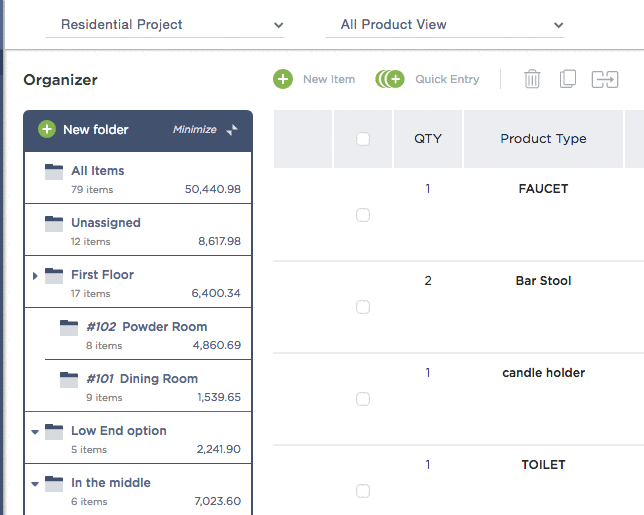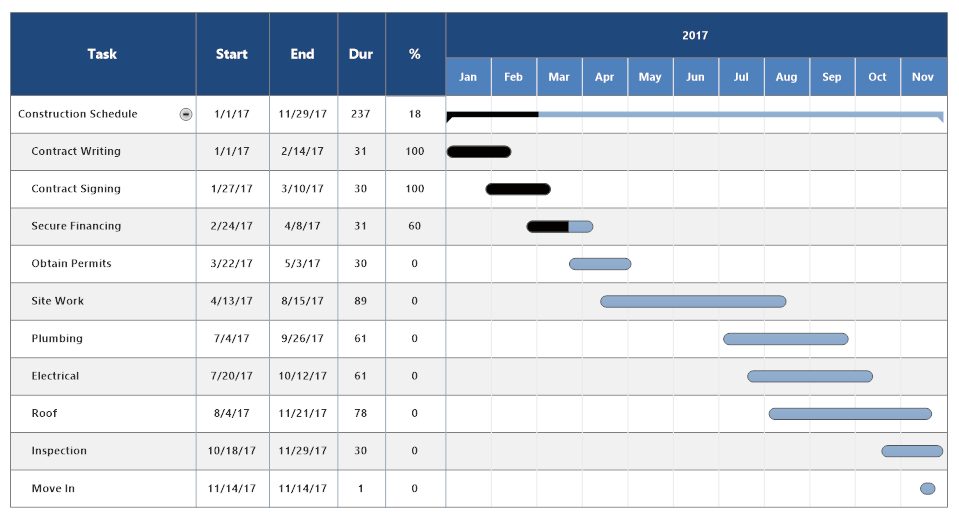
Manage FF&E specification, procurement, and product data at scale. Take on bigger projects with confidence and grow your firm with Fohlio. Schedule a demo or book a consultation with one of our account managers to explore these features today.
(Welcome to our two-part series on controlling building costs. This part focuses on the construction aspect. Catch up on the first part here.)
So you’ve got your plans all laid out. You, your crew, your designers, and your clients are all excited to see the project come to fruition.
Not to rain on your parade, but there are few things more awful than an uncompleted project because you ran out of funds.
No worries — with careful planning, constant reevaluation, and rapid adjustments, you’ll stay within your budget and deliver on time. Easily.
Here are 6 ways to control building costs during the construction phase:
Take Advantage of Construction Technology
Over the years, the phrase “construction tools” has come to mean more than the typical hammers, nails, and levels. These days, the definition also includes different types of software that help you save time and effort.
Here are a few construction programs you should check out:
- HCCS HeavyBid – Just in case you’re still not using this, HeavyBid is considered by many to be the industry standard in cost estimation. Besides being speedy and accurate, it also allows you to easily convert your data into a detailed bid — no more scrambling to meet bidding deadlines!
- Aconex – This construction management software lets you easily keep track of tasks and workflows, connect all your teams, view and mark up BIM models, and more.
- FingerCAD – With this CAD application, you can create technical drawings whenever and wherever the inspiration strikes. You can use it on iPad, then refine later on your desktop if you need to.
- Monograph – Managing projects and timekeeping are easy as pie with this software built by architects for architects. You can filter projects by status, phase, and more, and record hours per project, phase, and activity.
Break the Project Down Into Components
Even the smallest of projects can be overwhelming. Ever have those days when you’re reciting a list over and over under your breath, praying you don’t forget some small but crucial detail?
Split the project into smaller, more manageable chunks. According to the Construction Management of America, your project manager’s responsibilities can be divided into these seven categories:
- Project management planning
- Cost management
- Time management
- Quality management
- Contract administration
- Safety management
- Construction management professional practices (manage the team working on the project, define each person’s role and responsibilities, etc.)
FF&E and product management, on the other hand, can be broken down by:
- Schedule – Also called product categories or types, this is usually composed of flooring, lighting, finishes, plumbing, and more.
- Area – Divide the project into floors, and then subdivide the floors into rooms. You can be as detailed as you want to be.
- Theme – Client still torn between farmhouse and mid-century modern? Give each theme its own folder.
- Status – Tag each product with labels like, “Selection in progress,” “Approved by client,” “Ordered,” “Delivered,” and more.
A good FF&E specification software (*cough* Fohlio *cough*) can help you look at the project from an overall or detailed view.
For example, you can switch views from looking at all the products in all of the areas, to checking how all the plumbing parts for the master bedroom on the second floor are doing.

How will an ff&e specification software help your team?
Create Look-Aheads and Forecasts
It’s important to focus on what’s happening now, but it’s just as important to know what’s happening next. This helps you set expectations and avoid those pockets of wasted hours when people are standing around figuring out what to do next.
A Gantt chart or color-coded calendar will help you see, at a glance, which phases of the project are implemented from when to when, and also identify which tasks can overlap and which ones can’t. You can use something as sophisticated as SmartDraw, or something as simple as a spreadsheet.
Are you going to finish laying down floors and ceilings in two days? It’s probably a good idea to take a few minutes today to check if the paints and tiles are on schedule to arrive.

Are they going to be late? You can check on other parts of the project to see if there’s anything else you can bump up the schedule so you can work on it in the meantime.
See what you did there? You just prevented delays in your timeline (and possible increase in building costs), and all because you have the foresight.
Reevaluate Constantly
People may think a single family home is an inanimate object, but you and I know that it’s actually a living, breathing organism that’s sometimes cantankerous and uncooperative. That means, no matter how carefully you’ve thought everything out, some things are bound to change. “The best laid plans” and all that.
A couple of things to periodically check for are:
- Unexpected delays – Is the ground being more problematic than expected? Perhaps the landscaping plans should be reviewed. Is there termite damage that you didn’t see before? It may no longer be a good idea to save as much of the original structure as possible, even if you want to preserve the original architecture because it’s an officially recognized heritage site.
- Weather changes – Is a torrential storm coming your way in a few days? You may want to put off exterior finishes and focus on interior work like fireproofing in the meantime. This way, your project will still have the best chances of getting delivered on time.
Manage Change Orders Thoroughly
No one likes change orders: They incur additional building costs, cause delays, and often change other aspects of construction. However, they’re often unavoidable, which means you’ll just have to do your best to be prepared.
Here are a few things you can do to mitigate damages:
- Specify as early as possible. Create your punch list, fill in the details, and then present them to your clients. Making decisions early will allow them to see the items in person, if they wish. It minimizes the chances that they will send something back because it looks nothing like its picture in the catalog.
- Check items as soon as they’re delivered. As in, don’t even let the delivery guys leave before you’ve examined them for damages and incorrect specifications (like size, color, etc.). The turnaround for exchanges is faster when you don’t have to wait for them to come back to pick up the item, take it back to the warehouse, etc.
- Build a contingency fund into the budget. Believe me, you’ll need it. There are few things worse than having a project stall or (gasp!) not finish because of a lack of money. And hey, if you do end up not using it, maybe you can celebrate with pizzas all around.
Keep Everyone Updated
At least once in your professional life, you would have run into having to redo parts of a project because, someone, somewhere, had failed to tell someone else about changes and updates.
Here are a few ways to prevent this:
- Every two or three days, give your clients a quick call or send a short email detailing progress on the project. Give them a list of things you accomplished since you last spoke, and let them know what you’re going to do over the next few days.
- Let everyone involved in the project know as soon as any changes are made to the plan. There are few things more amateurish than having to knock down a structure because they weren’t told that it was no longer necessary or that the dimensions have changed. Not only that, but it’ll cost you additional in materials and labor hours.
- Make it a rule to check for changes every day, before construction begins.
Do you have any tips on controlling building costs during the construction phase? Tell us in the comments below!
In the meantime, take a look at all the things Fohlio can do to make Construction product specifications, include FF&E , finishes, construction, installation, and electro mechanical products, faster and easier.
Manage FF&E specification, procurement, and product data at scale. Take on bigger projects with confidence and grow your firm with Fohlio. Schedule a demo or book a consultation with one of our account managers to explore these features today.
Expore Fohlio
Learn how to:
- Save days of work with faster specification
- Create firm-wide design standards
- Automate and centralize procurement
- Keep your whole team on the same Page
- Manage product data
- Track budget against cost in real time.
- Prepare for asset valuation
Published Mar 19, 2018

